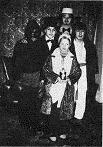Introduction
Whether on paper or on the Internet, there is plenty of documentary
evidence to suggest that the urge to rewrite folk plays is irresistible.
Some of these modern plays are simply adaptations of traditional texts,
but most are totally new compositions written in the traditional style,
whatever that means. And this last remark is really is the subject of
this paper. Modern folk play compositions raise a host of questions.
Why do people write them, and how? What makes the plays seem authentic?
Is it more than having a rhymed script? More than wearing costumes
swathed in ribbons and streamers? Just what is it? These are interesting
questions in their own right, but the answers may also have implications
for folk play history. If the influences and factors that operate today
also held sway in the past, then by studying the modern compositions we
may gain a valuable insight into how the different traditional play
variants emerged and evolved.
Previous Work
The introduction of modern historical personages into the plays has been
noted by various authors, including J.H.Ewing (1884), R.J.E.Tiddy (1923)
and Alex Helm (1965). These characters are indicative of at least partial
rewriting or supplementary composition during the history of the plays.
The only previous in-depth study of newly-composed folk plays I can find was
conducted by Ian Russell on the Brut King play of Jacksdale, Nottinghamshire
in the 1970s (I.Russell, 1981a).
|
|
Jacksdale was the home of a traditional hero-combat play, performed
at Christmas and featuring the character Bullguys (spellings vary). The
actors were known as Bullguisers, possibly a conflation of the character
name with the name Guisers commonly used in the region and elsewhere.
In the mid 1970s, a new teenage group of Bullguisers decided to
perform the play. Keith Flint, the tradition bearer from the previous
generation provided them with the script, but it did not gel. Instead
therefore, he decided to update the play, the result being a brand new
script incorporating current celebrities, fashions, jingles and topical
events.
|

Fig.1 - Jacksdale Bullguisers
Click on thumbnail
to view full-size
|
|
Russell interviewed Keith Flint to determine his methods and
motivation. Flint said his aim was to update the script to make it funnier
and more entertaining. Its topicality is reflected in the cast
illustrated in Figure 1. Brut King - one of the protagonists - was
based on the boxer Mohammed Ali, who at the time featured in a
television advert for Fabergé's Brut cologne for men.
His opponent - Kung Fluey - was inspired by the then popular kung fu
genre of films and television programmes. The Referee, of course,
mediated the fight. Slack Alice was borrowed from the repertoire of the
effeminate comedian Larry Grayson.
While the characters were new, and indeed most of the script, Flint
felt it was important to keep some traditional features. Therefore he
retained the classic hero-combat plot where one disputant is felled by
the other, and the doctor (in this case played by Slack Alice) revives
him. Enter In or Opener still started the play with the traditional
verse, and the play ended with a Christmas carol
With the new script in place, the play was performed in the
traditional context, with numerous performances taking place over
three Christmas seasons, mainly in pubs in and around Jacksdale. They
had a good reception, but the actors were made aware of audience
expectations for the traditional characters Bullguys and Betsy Bellsybub,
who were missing from the play. At the end of three years, the novelty
had worn off, both with the actors and the audience, so in the end
they reverted to the tried and tested traditional text.
|